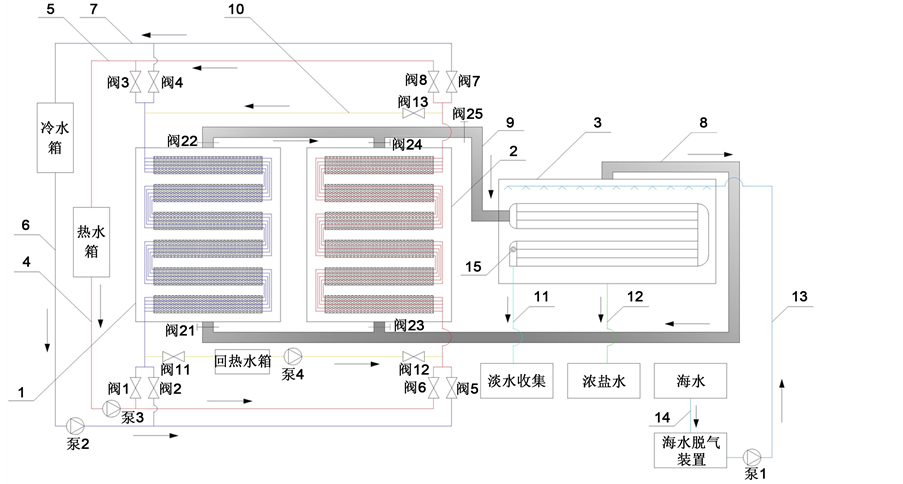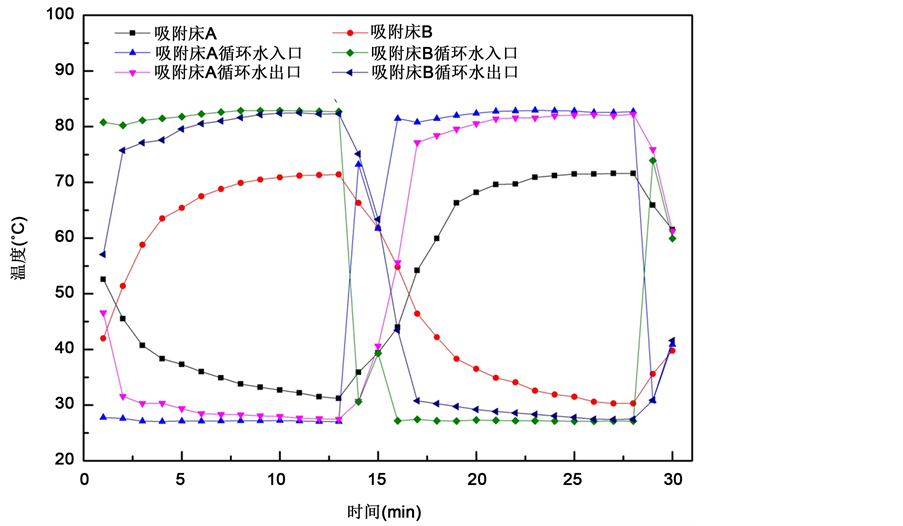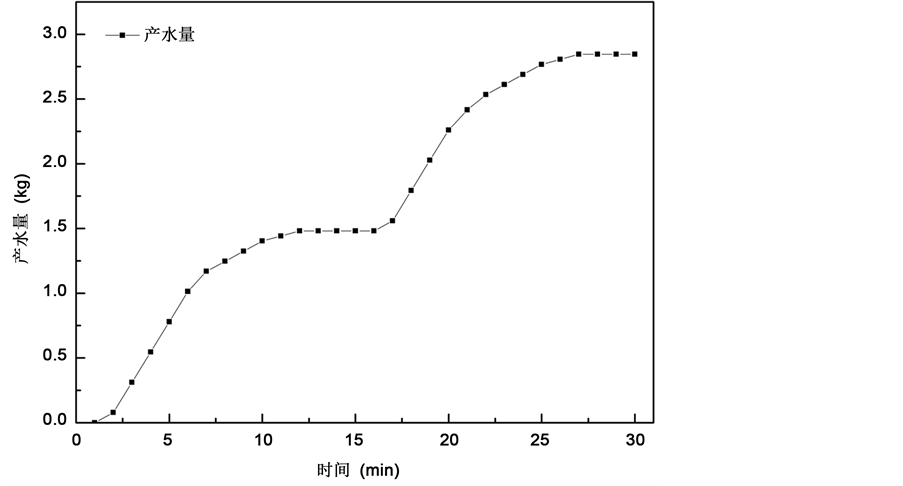1. 引言
传统海水淡化的主要方法包括蒸馏法、膜法、结晶法等。然而,传统海水淡化技术基础投资和运行费用均十分高昂。利用传统能源进行海水淡化会消耗大量资源。而太阳能、风能和地热等新兴能源将是新的海水淡化驱动力发展方向。
多孔硅胶对水蒸气有很强的亲和力,能够在相对较低的温度下解吸所吸附的水蒸气,这一特点使得低温热源驱动的水蒸气吸附/解吸技术(吸附脱盐技术)淡化海水成为可能。吸附脱盐技术的另一优点是蒸发温度较低,伴随卤水蒸发的卤化氢气体相对较少,因而产出水有较高的纯度。而沸石所需要的脱水再生温度较高。
由于所需驱动热源温度较低,近年来吸附式海水淡化(AD)系统受到了相当大的关注 [1] 。AD系统循环能够同时生产两种产品:冷量和淡化水 [2] [3] 。为解决热量损失问题,需要更好的性能提升方案。Thu等 [4] [5] 首次对AD系统提出了热量回收的两种可能的方案:(1) 合并蒸发器和冷凝器;(2) 热回收管路即冷却水管分别通过冷凝器和蒸发器。
我国目前在吸附式海水淡化方面的研究非常有限,已有研究主要集中在对吸附式海水淡化技术的介绍和理论分析层面。曾辉等 [6] 指出吸附式海水淡化是利用某些固体物质对水蒸气的吸附和解吸作用而运行。王永青等 [7] 以硅胶和硅胶-CaCl2为吸附剂,指出ARSD系统性能随淡水回收率提高而降低。
为探索吸附式海水淡化的前景并为其提供基础数据和科学依据,本文设计并搭建了吸附式海水淡化装置进行实验,分析了系统运行性能,并对制取的淡化水水质进行了检测。
2. 吸附式海水淡化实验简介
2.1. 吸附式海水淡化实验装置
实验所用的带有回热回质循环的吸附式海水淡化系统(专利公开号CN105967258A)如图1所示,吸附/解吸的过程由床A和床B交替进行。回质和回热过程通过阀门的切换完成。真空泵用于保持系统的真空度。
 1.吸附/解吸床A2.吸附/解吸床B3.降膜蒸发器4.热水供水管5.热水回水管 6.冷却水供水管 7.冷却水回水管8.蒸汽管路(供吸附床) 9.蒸汽管路(供降膜蒸发器) 10.回热循环管路 11.淡水收集管 12.浓盐水排放管13.脱气后海水供水管14.海水供水管 15.不凝性气体排放孔
1.吸附/解吸床A2.吸附/解吸床B3.降膜蒸发器4.热水供水管5.热水回水管 6.冷却水供水管 7.冷却水回水管8.蒸汽管路(供吸附床) 9.蒸汽管路(供降膜蒸发器) 10.回热循环管路 11.淡水收集管 12.浓盐水排放管13.脱气后海水供水管14.海水供水管 15.不凝性气体排放孔
Figure 1. System diagram of absorption desalination system
图1. 吸附式海水淡化系统图
本文设计的吸附床采用翅片管式换热器。并填充颗粒状细孔球形硅胶,粒径 0.5~1.5 mm。吸附床中主要构成材料为硅胶29.17 kg,紫铜7.77 kg,铝合金5.27 kg,铝18.13 kg。其比热容分别为0.920 kJ/(kg∙K), 0.384 kJ/(kg∙K),0.903 kJ/(kg∙K),0.896 kJ/(kg∙K)。
0.5~1.5 mm。吸附床中主要构成材料为硅胶29.17 kg,紫铜7.77 kg,铝合金5.27 kg,铝18.13 kg。其比热容分别为0.920 kJ/(kg∙K), 0.384 kJ/(kg∙K),0.903 kJ/(kg∙K),0.896 kJ/(kg∙K)。
横管降膜蒸发器选用不锈钢管作为换热管。蒸发器管内为解吸出来的水蒸气,管外为海水。两者之间通过热交换,水蒸气凝结为水,部分海水汽化为水蒸气。
2.2. 实验流程
在一个完整循环开始时,床A刚完成解吸处于较高压力,床B刚完成吸附处于较低压力。此时两床气体管路连通,两床间的蒸汽压力平衡,床A压力降低,促使吸附剂中的水分解吸;床B压力升高,促使吸附剂吸附水蒸汽。随后,两床间的液体循环流动,实现两床间的回热:床B被加热,床A被冷却。紧接着,床B通入热水进行解吸,蒸汽进入降膜蒸发器的冷凝管,所放冷凝热使管外海水升温并部分汽化。与此同时,床A通入冷水进行吸附,由海水汽化产生的蒸汽进入床A,直至吸附接近饱和。未蒸发的浓盐水排放至浓盐水箱,冷凝管内冷凝产生的淡水进入淡水收集箱。整个过程中,床A与床B交替通冷热水。表1是吸附式海水淡化系统的设定运行参数。
2.3. 数据测量
本实验台需要测定并记录的数据包括三类:温度、压力、流量。除吸附/解吸床的进出口温度及流量由热量表测量外,其余温度数据均由PT100温度计测量。压力由真空压力表测得。实验数据以人工记录为主。图2是是所研制实验装置的实物图。
对制取的淡化水水质检测包括色度、pH、总硬度、挥发酚类等14项指标。并将检测结果与国家饮用水卫生标准和其他传统海水淡化技术所产淡化水的水质对比。

Figure 2. Photo of absorption desalination experimental device
图2. 吸附式海水淡化实验装置实物图

Table 1. Set running parameters of the absorption desalination system
表1. 吸附式海水淡化系统的设定运行参数
3. 实验结果与讨论
在系统进入稳定运行时海水温度30℃,海水喷淋量为180 L/h,热水入口温度为83℃,冷却水入口温度为27℃。系统采用780 s的加热/冷却时间、30 s的回质时间和90 s的回热时间,完整循环时间30 min。
3.1. 系统各部分压力变化
在实验进入稳定运行阶段,系统内各部位压力在一个完整的循环里随时间变化的规律如图3所示(循环开始时,A床吸附,B床解吸)。

Figure 3. Pressure variation with time at each part in a complete cycle
图3. 完整循环中各部位压力随时间的变化
从图3可以看出,吸附床的压力始终大于降膜蒸发器蒸发侧压力,这是由于吸附床吸附水蒸气,促使降膜蒸发器蒸发侧的海水蒸发进入吸附床。另外解吸床的压力一直大于降膜蒸发器冷凝侧压力,这是由于降膜蒸发器冷凝侧的水蒸气与蒸发侧冷海水换热,使得冷凝侧的压力低于解吸床的压力,同时促使解吸出来的水蒸气进入降膜蒸发器冷凝侧而被冷凝,产出淡水。这种压力变化驱动吸附式海水淡化循环不断进行。
3.2. 系统各部位温度变化
系统各部分温度变化如图4所示,回热循环结束时A床温度升高至44℃,B床温度降低至55℃,表明回热循环从解吸床回收了一部分热量至吸附床,节约了冷量和热量。
根据吸附床材料的总热容,以及回热过程A床温度升高13.2℃,B床降低13.2℃,可得每个回热循环回收热量1356.4 kJ。从吸附/解吸过程中间阶段到末段(6~13 min),冷热循环水进出口之间的温差已经降至0.3℃~2℃之间,而吸附/解吸床与冷热循环水之间的温差仍比较大,尤其是解吸床与热水循环水之间的温差,在10℃~12℃之间,表明吸附床翅片与硅胶颗粒之间的导热能力没有达到最佳效果,吸附床的换热性能还有很大的提升空间。
3.3. 产水量变化规律
图5为系统产水量变化。系统的产水量为5.7 kg/h。在回质阶段(13~14 min),解吸床压力降低,会发生二次解吸;吸附床压力升高,会发生二次吸附。这部分被二次解吸/吸附的水蒸气将在下一个循环阶段进入降膜蒸发器冷凝侧,冷凝成淡水并被收集,相当于二次吸附/解吸的水蒸气在下一个循环阶段被计入产水量。在回热阶段(14~15 min),系统回收了一部分热量,节省了冷量,但从图5可知,回热过程并不能提高系统的产水量。在系统稳定运行阶段,,系统的最佳循环周期为20 min,当循环周期超过20 min时,周期越长,系统的单位时间产水量就越小。
3.4. 淡化水水质分析
实验所得淡化水的水质关键指标检测结果,如表2所列,同时给出了该检测结果与国内已经运行的典型海水淡化设备所产淡化水及《生活饮用水卫生标准》(GB 5749--2006)限值的对比。

Figure 4. Temperature variation with time at each part in a complete cycle
图4. 完整循环中各部位温度随时间的变化

Table 2. Main indicators for water production of absorption desalination and its comparison with other methods and drinking water standard
表2. 吸附式海水淡化淡化水主要指标与其他方法和饮用水标准的对比

Figure 5. Water production with time at each part in a complete cycle
图5. 完整循环中系统产水量随时间的变化
制取的淡化水中挥发酚类超标,污染来自海盐预杀菌过程微量有机物转化为挥发类物质。而挥发酚类又能够随蒸汽挥发进入吸附床,并在降膜蒸发器的换热管内冷凝进入淡水收集箱,因此导致淡化水中挥发酚类浓度超标。淡化水中氟化物超标,原因在于当地工厂排放的废气中含有的氟化物进入淡化水收集设备,对制取的淡化水造成污染。对比结果表明,吸附式海水淡化技术作为蒸馏法海水淡化技术中的一种,其淡化水的各项特征与传统的蒸馏法海水淡化所产淡化水的特征趋于一致。
4. 结论
本文设计并研制了吸附式海水淡化系统,并通过实验研究了该系统运行性能。系统稳定工况为:热水入口温度、冷却水入口温度、海水温度和海水喷淋流量分别为83℃、27℃、30℃和180 L/h,采用780 s的加热/冷却时间、30 s的回质时间和90 s的回热时间,循环周期为30 min。在上述条件下得出的主要结论为:
(1) 系统的产水量达到了5.7 kg/h。系统的单位时间产水量与循环周期时间有关,在循环周期超过20 min时,循环周期越长,系统的单位时间产水量就越小:
(2) 系统采用回热循环虽不能增加系统单位时间的产水量,但可以回收部分热量,降低单位产水量的能耗。每个回热循环回收1356.4 kJ热量;
(3) 与《生活饮用水卫生标准》(GB 5749-2006)对比,除挥发酚类和氟化物外,制取的淡化水主要指标均达到生活饮用水卫生标准限值的要求,各项特征与传统海水淡化技术所产淡化水的特征基本一致。
基金项目
海洋经济创新发展区域示范项目(cxsf-42)。国家科技支撑计划项目(项目编号2015BAJ01B02)。
NOTES
*通讯作者。